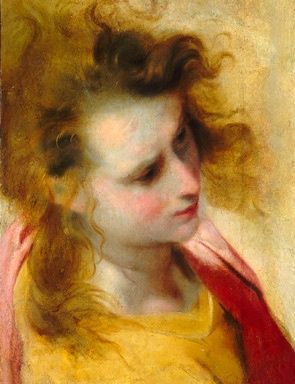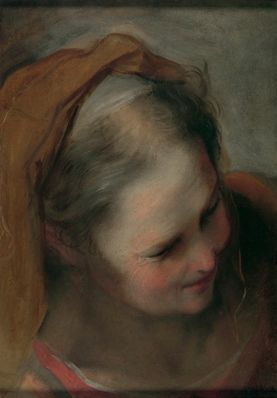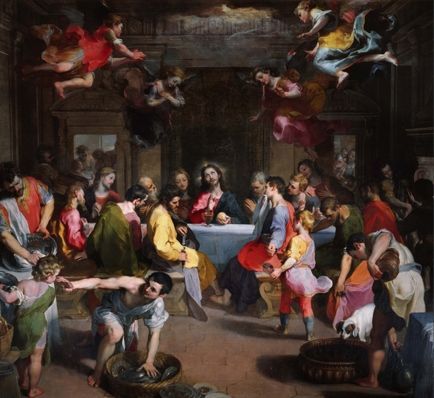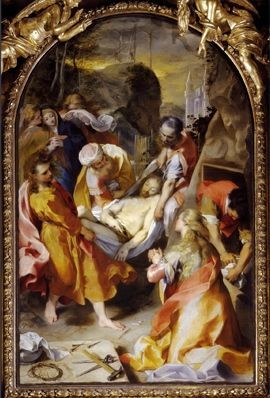First major monographic exhibition dedicated to the art of Federico Barocci opens in London
Federico Barocci, 'Self-Portrait', about 1595-1600. Oil on paper mounted on canvas, 41.5 x 32.5 cm. Galleria degli Uffizi, Florence - © 2013. Photo Scala, Florence - courtesy of the Ministero Beni e Att.
LONDON.- This Spring, the National Gallery presents the first major monographic exhibition, dedicated to the art of Federico Barocci (1535-1612). The display assembles the majority of Barocci’s greatest altarpieces and paintings, together with sequences of dazzling preparatory drawings, allowing visitors to understand how each picture evolved. 'Barocci: Brilliance and Grace' showcases the remarkable fertility of Barocci’s imagination and the diversity of his working methods.
Highly revered by his patrons during his lifetime, Barocci combined the beauty of the High Renaissance with the dynamism of what was to become known as the Baroque, a genre he was instrumental in pioneering. From his earliest creations of the 1550s, he began to challenge pictorial convention by positioning his figures in dynamic spatial arrangements, anticipating by almost half a century the innovations of Baroque art. He was an incessant and even obsessive draughtsman, preparing every composition with prolific studies in every conceivable medium. Fascinated and inspired by people and animals, he infused his harmonious compositions with infectious charm and an unparalleled sensitivity to colour. Spiritually attuned by nature, Barocci was predominantly a painter of religious subjects, his approach epitomising the clarity and accessibility required by a Catholic church, then in crisis. Barocci’s unique warmth and humanity transformed familiar gospel stories and more unusual visions into transcendent archetypes with universal appeal.
Highlights of the exhibition include Barocci’s most spectacular altarpiece, 'The Entombment of Christ' from the Marchigian seaside town of Senigallia and 'Last Supper' painted for Urbino Cathedral, neither work ever having left Italy before. Two other splendid late altarpieces for Roman churches, the 'Visitation' from the Chiesa Nuova and the 'Institution of the Eucharist' from Santa Maria sopra Minerva, also are displayed. In addition, the exhibition also includes Barocci’s finest portraits, smaller devotional paintings, his only secular narrative ('Aeneas Flight from Troy'), and more than 65 preparatory drawings, pastel studies and oil sketches – the latter techniques pioneered by the ever experimental Barocci long before they became standard artistic practice.
Born in the Marchigian town of Urbino, Federico Barocci was one of the most talented and innovative artists of late 16th-century Italy. He flourished in a town that had become one of the great cultural centres of the Renaissance, and had also been the birthplace of his famous predecessor Raphael, by whom he was much influenced. He emerged as a promising young painter and, in the 1550s, moved to Rome for further study. During a second trip to Rome in the 1560s, Barocci lived and worked with a number of Rome’s leading painters. After participating in a fresco project for Pope Pius IV in the Vatican, he was allegedly poisoned by jealous rivals during a picnic. Suffering severely and in need of recuperation, Barocci returned to Urbino in 1563, where he remained for the rest of his career. When he died in 1612, he was not only among the highest paid painters in Italy, but also one of the most influential.
Many of Barocci’s most accomplished works remain in his home region of the Marches, Italy, on the altars for which they were made. Consequently, his name has not acquired the broad recognition of distinguished predecessors such as Raphael and Michelangelo, or successors such as Rubens, who, with other Baroque artists, drew inspiration from his sumptuous colour palette, expressive compositions and innovative techniques. Beloved by artists and art historians throughout the ages, those unfamiliar with Barocci’s art should prepare to be astonished by his brilliance and grace.
'Barocci: Brilliance and Grace' is curated by Carol Plazzotta at the National Gallery. It was first shown in a different form in Saint Louis, where it was curated by Judith W. Mann and Babette Bohn.
Federico Barocci, Head study for Saint John the Evangelist. Oil on paper lined with linen, 42 x 31.7 cm. National Gallery of Art, Washington. Ailsa Mellon Bruce Fund 1979. 1979.11.1. Ailsa Mellon Bruce Fund, Image courtesy National Gallery of Art, Washington.
Federico Barocci, 'Oil study for the head of Saint Elizabeth'; Brown, ochre, white, peach, and orange oils on paper, laid down on canvas. 39.1 x 27.4 cm. © The Metropolitan Museum of Art/Art Resource/Scala, Florence
Federico Barocci, 'Last Supper', 1590-99. Oil on canvas, 298 x 318 cm. Chapel of the Santissimo Sacramento, Cathedral, Urbino. Photo © Scala, Florence - courtesy of Ufficio Beni Culturali Diocesi di Urbino.
Federico Barocci, 'Entombment of Christ', 1579-82. Oil on canvas. 295 x 187 cm. Diocesi di Senigallia - Chiesa della Croce, Senigallia. © 2013. Photo Scala, Florence.
Federico Barocci, 'Visitation', 1583-86. Oil on canvas. 285 x 187 cm. Santa Maria in Vallicella (Chiesa Nuova) © Francesco Cantone, Archivio della Congregazione dell'Oratorio di Roma, Archivio Fotografico ACOR.

Federico Barocci (1535-1612), Aeneas Fleeing Troy, 1598. Oil on canvas, 179 x 253 cm. Galleria Borghese, Rome 68. Soprintendenza Speciale per il Patrimonio Storico, Artistico ed Etnoantropologico e per il Polo Museale della città di Roma
Federico Barocci, 'Studies for the Virgin's Hands'; Charcoal with red and pink pastel heightened with white on blue paper. 27.3 x 39.4 cm; Staatliche Museen zu Berlin, Kupferstichkabinett © Volker-H. Schneider

/https%3A%2F%2Fprofilepics.canalblog.com%2Fprofilepics%2F1%2F0%2F100183.jpg)
/https%3A%2F%2Fstorage.canalblog.com%2F03%2F02%2F119589%2F96711876_o.jpg)
/https%3A%2F%2Fstorage.canalblog.com%2F11%2F31%2F119589%2F94773502_o.jpg)
/https%3A%2F%2Fstorage.canalblog.com%2F20%2F83%2F119589%2F94772815_o.jpg)
/https%3A%2F%2Fstorage.canalblog.com%2F26%2F72%2F119589%2F75604929_o.jpg)
/https%3A%2F%2Fstorage.canalblog.com%2F59%2F60%2F119589%2F26458628_o.jpg)









/http%3A%2F%2Fstorage.canalblog.com%2F26%2F75%2F119589%2F111943788_o.jpg)
/http%3A%2F%2Fstorage.canalblog.com%2F38%2F45%2F119589%2F95934402_o.jpg)
/image%2F1371349%2F20240520%2Fob_1750ee_telechargement-4.jpg)
/image%2F1371349%2F20240520%2Fob_243c6e_telechargement-3.jpg)